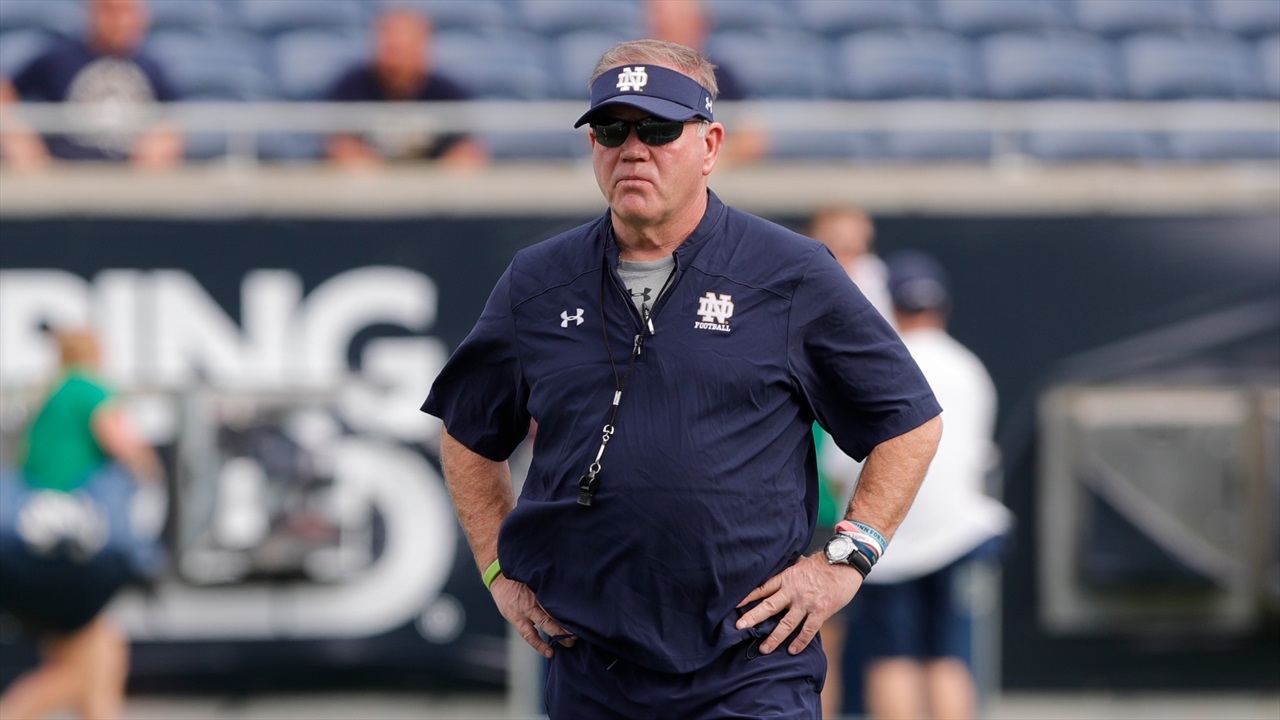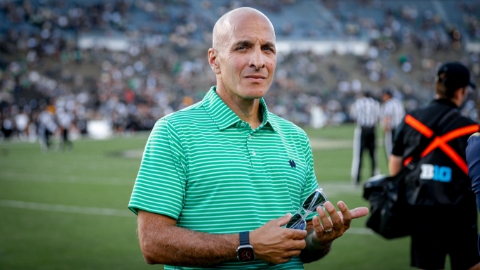
For the first in awhile, the Notre Dame beat was able to speak with Brian Kelly via Zoom. With so many things changing in recent weeks, there was a lot of information to unpack from his answers.
I’d recommend reading Matt Freeman’s and John Brice’s pieces on Notre Dame’s outline for Covid-19 protocols, the possibility of no on-campus recruiting visits, and the lack of clarity on the schedule if you’re looking to catch up.
Kelly’s answer regarding scheduling is what interested me the most. It’s not a surprise that there’s confidence regarding the ACC games going on as scheduled (minus some potential venue changes) or that the Navy game is pretty much locked in. This was the first time I have heard anyone speak publicly about the potential for other games to fall through, though, with Kelly specifically mentioning the Big Ten and Pac-12 matchups.
“One of the things we have to keep in context of what our schedule looks like is, what happens in the Big Ten and what happens in Pac 12? Those are two impactful games that influence our schedule (vs. Wisconsin at Lambeau Field and vs. USC at Los Angeles Coliseum), maybe Western Michigan.”
I know that Notre Dame and every school is looking at other options if some Power 5 conferences do decide to go with a conference only schedule. Let’s say the Big Ten (Wisconsin), Pac-12 (Stanford and USC), and SEC (Arkansas) are off the table. Where does Notre Dame turn to from there?
Would AAC teams jump at the chance to play Notre Dame? It would seem like a great opportunity for these schools to take a shot at beating the Irish. Most of them may never get a chance and with their conference being so spread out, keeping it within the conference doesn’t make as much sense for them.
Central Florida and Cincinnati, both projected in the top-25 this season, would be intriguing games that could replace some of the lustre of losing those other matchups. Normally they would be the kind of teams a power program would want to avoid, but Notre Dame may need quality opponents to make up for the blows to the strength of schedule.
As an independent, BYU is an obvious choice and Notre Dame still owes them a home game. This may be the year that debt gets paid. They are almost always a solid opponent as well.
The short list of other independents aren’t nearly as impressive, but Army seems like another candidate who will need games if all of these schedules are being picked apart.
Is it possible that another ACC program might want to add a game against Notre Dame? I wouldn’t put it in the “likely” category, but those programs might not have a choice if they are losing non-conference opponents as well.
The goal with rebuilding a schedule should be to find the right path to having a shot at the College Football Playoff. This situation could make that very difficult. But if programs like Central Florida and Cincinnati want to be taken seriously as more than the best Group of 5 program, playing Notre Dame is something their athletic directors should be fighting for.
2. Here’s what Kelly had to say about not having recruits visit campus.
“We seem to think that with all the precautions that are being taken, relative to your own campus, relative to testing, how is that you can fly in somebody, a family, that hasn’t been tested, put them up on your campus and your hotels and let them walk around campus freely? I just seem to think that’s going to be hard to navigate through this in the fall. There’s still work to be done; I don’t think it’s going to happen quickly. If it does happen, we’ll be excited about it but we’ll be very cautious and we’ll have a lot of questions. So, I guess the long answer to your question is, we’re operating as if you will not visit this campus this recruiting season, and we have to take our campus to you.”
It’s pretty difficult to argue against that if the testing is not in a position to make this safe for outside visitors. That’s something that every program would have to take into consideration because of the risk of having it impact their season.
The next question is whether or not this is going to be something that the NCAA controls when it comes to visits. Because if they don’t, I imagine that some programs, specifically in the SEC and ACC, will be open to visits.
Opening things back up at different times for voluntary workouts is one thing, but this would be a much bigger advantage for not just this recruiting cycle, but for the 2022 and 2023 class.
3. The piece I did yesterday on programs that develop 3-star talent into impact players (selected in the first three rounds of the NFL Draft) focused on those teams, but there’s a lot more interesting things I learned from doing the research.
Maybe the one that intrigued me the most was the fact that 44 out of those 100 3-star recruits were defensive backs. That’s a pretty good chunk and more evidence that it’s possible to find an underrated talent that can be much better than his ranking.
In this most recent draft, Utah defensive back Terrell Burgess was ranked 1038th overall as a recruit. Clemson’s Tanner Muse was 706th. Mississippi State’s Cameron Dantzler was 760th. Utah’s Julian Blackmon was 935th. Cal’s Ashtyn Davis was unranked. Iowa’s Michael Ojemudia was 1795th. Minnesota’s Antoine Winfield Jr. was 1415th. TCU’s Jeff Gladney was 1558th. Ohio State’s Damon Arnette was 653rd.
You could call these whiffs by the recruiting services, but it does highlight the fact that development is a huge part of defensive back play. Of course everyone wants a 5-star elite athlete like Jeff Okudah on their roster, but quality can be identified and developed that doesn’t check all of the boxes in high school.
4. The state that had the most 3-star gems out of those 100 was Texas (14). The state after that was California (10). Throw them in with Georgia (7), Florida (7), Louisiana (7), and North Carolina (5) and 50% of those underrated prospects came from six states.
This isn’t to say that these gems can’t be unearthed in smaller states like Wyoming (Florida’s Taven Bryan) or even Canada (Georgia Tech’s Adam Gotsis), but for whatever reason, it seems like more recruits with high ceilings get overlooked in states like Texas.
It’s a default question to ask if a player from the Lonestar state has an offer from Texas or Texas A&M, but if the staff really trusts their evaluation, it doesn’t matter if there’s a Xavien Howard (Baylor), Josh Jackson (Iowa), or James Washington (Oklahoma State) potentially out there to find.
5. So much of coaching in sports is being a copycat. There is more modification than true innovation and there’s nothing wrong with that.
Who Notre Dame chooses to emulate on offense, or at least be inspired by, is something I am extremely curious to find out with new coordinator Tommy Rees.
I wouldn’t be surprised if we see more teams try and do what LSU did. They spread it out to a point where they had three receivers (11 personnel with one back and one tight end) over 80% of the time.
They were an explosive offense because of their passing game, but try is the right word for it because it’s going to be tough for teams to have similar results without Joe Burrow and trio of stud receivers.
I don’t see Notre Dame matching that at quarterback or receiver, which is one reason why I would be interested to see more of a San Francisco 49ers influence on the Notre Dame offense, which is something I have written about before.
The more time that has passed, the more I have thought about Notre Dame using Tommy Tremble much like the 49ers use Kyle Juszyck. He’s really a hybrid of a fullback/H-back and it allows them to play 21 personnel (two backs, one tight end), but be able to interchange from 12 (one back, two tight ends) to 21 on any given play while keeping the same players on the field.
That puts stress on a defense and the more I think about Notre Dame’s tight end depth chart with Tremble and true freshman Michael Mayer, the more I can see the possibilities.
I think it’s something that could really help Tremble’s value in the eyes of NFL scouts as well because he may never have the body type to be a traditional tight end, but he has the skills to be used in a variety of ways in an offense.
6. This recent quote from former Baylor coach and now Carolina Panthers coach Matt Rhule had the wheels spinning in my brain.
“I don’t like to judge people based upon their experiences in other systems with other people. I love to see what they do for us- if, if if - I think they have the traits that we need. That’s probably the college coach in me feeling that when you recruit, you recruit certain traits and you try to develop them.”
This was talking about him taking chances on guys who weren’t successful with other teams in the NFL, but this made me think of Notre Dame’s recent run on graduate transfers. Two of them, Isaiah Pryor and Trevor Speights, weren’t considered successful at their previous programs. Both of them have two years left of eligibility so maybe the thinking with them is similar to how Rhule is approaching things in the NFL.
They have traits that the coaching staff likes and they believe they can develop them in Notre Dame’s system.
The Irish haven’t taken many grad transfers since the rule was adopted. They have had five since 2013 with only Cody Riggs becoming a significant contributor. They’ve taken four in this year alone.
We’ll see if this becomes the norm for Notre Dame of if this is a one year blip, but if even two of the four work out well and become starters in 2020, then I could see the staff making that Matt Rhule philosophy a bigger part of their overall roster construction strategy.

